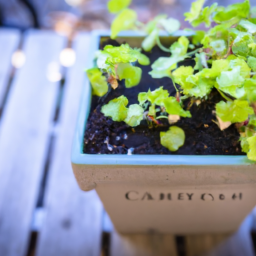How To Start Container Gardening
Table of Contents []
- How To Start Container Gardening
- Choosing the Right Containers
- Choosing the Right Soil
- Water Requirements
- Light Requirements
- Potting and Re-potting
- Pest Control
- Final Word
How To Start Container Gardening
How To Start Container Gardening
Container gardening is one of the most accessible and low-maintenance ways to grow plants. Whether it's at home, in the office, or just outside your window, the process is simple enough for anyone to pick up. But starting a container garden can be daunting. Here, we'll provide an in-depth look at everything you need to know about it, including key pieces of advice backed by research.
Choosing the Right Containers
The containers you choose for your container garden will depend on your budget and the type of plants you wish to grow. Containers can range from expensive terracotta containers to repurposed wine bottles. Generally, the larger the container, the more soil it can hold, allowing the roots to expand more readily.
Another important factor to consider is drainage. Too much water can cause the plant to drown, while too little water can induce dehydration. Therefore, you should look for containers that have drainage holes at the bottom or along the sides.
Types of Containers
The type of container you choose depends on several factors, such as size, shape, and material. If you're looking for something small, opt for a shallow bowl. For larger plants, you might want to opt for plastic or ceramic containers, which are better suited to accommodate the roots. Additionally, terracotta containers are great for retaining moisture, although this material tends to be more expensive.
Choosing the Right Soil
When it comes to choosing the right soil for your plants, it's important to do your research. The type of soil you select should depend on the type of plants you're growing. Generally, plants require a soil mix that is light and well-draining. Loose soil is best for plants that prefer more air and less water.
Adding Fertilizers and Mulch
To give your plants the nutrients they need to thrive, you should also consider adding correct fertilizer and mulch. Fertilizer provides essential nutrients to your plants while mulch helps retain moisture and keep weeds away. When fertilizing, be sure to follow the instructions on the package as overfertilizing can lead to poor plant health.
Water Requirements
Water is an essential part of container gardening as it helps the plants to take up the nutrients and oxygen they need to survive. The amount of water each plant needs will depend on the type of plant, its size, and the size of the container. Generally, plants should be watered when the top inch of soil is dry.
Light Requirements
Light is also important for the health of your plants. Most indoor plants require at least six hours of sunlight per day, while outdoor plants require more. If the light is insufficient, you can consider using artificial light to supplement.
Potting and Re-potting
When starting a container garden, it's important to consider how often the plants need to be re-potted. As the plants grow, they'll need to be re-potted into bigger containers. Generally, this should be done every two to three years or when the roots begin to grow out of the container.
Pest Control
Pests can wreak havoc on a garden, so it's important to be mindful of them. Common pests include aphids, spider mites, and white flies. To manage these pests, you can use an insecticidal soap or spray. To prevent the pests from returning, always keep the area around the plants clean and tidy.
Final Word
Container gardening is an easy and low-maintenance way to begin gardening, but there are several key steps you need to take in order to ensure successful growth. From choosing the right containers and soil to monitoring light and pest levels, these are just some of the essential tips you should keep in mind when starting a container garden. With the right knowledge and preparation under your belt, you'll be well on your way to creating a flourishing container garden.

Previous Page
Next Page
